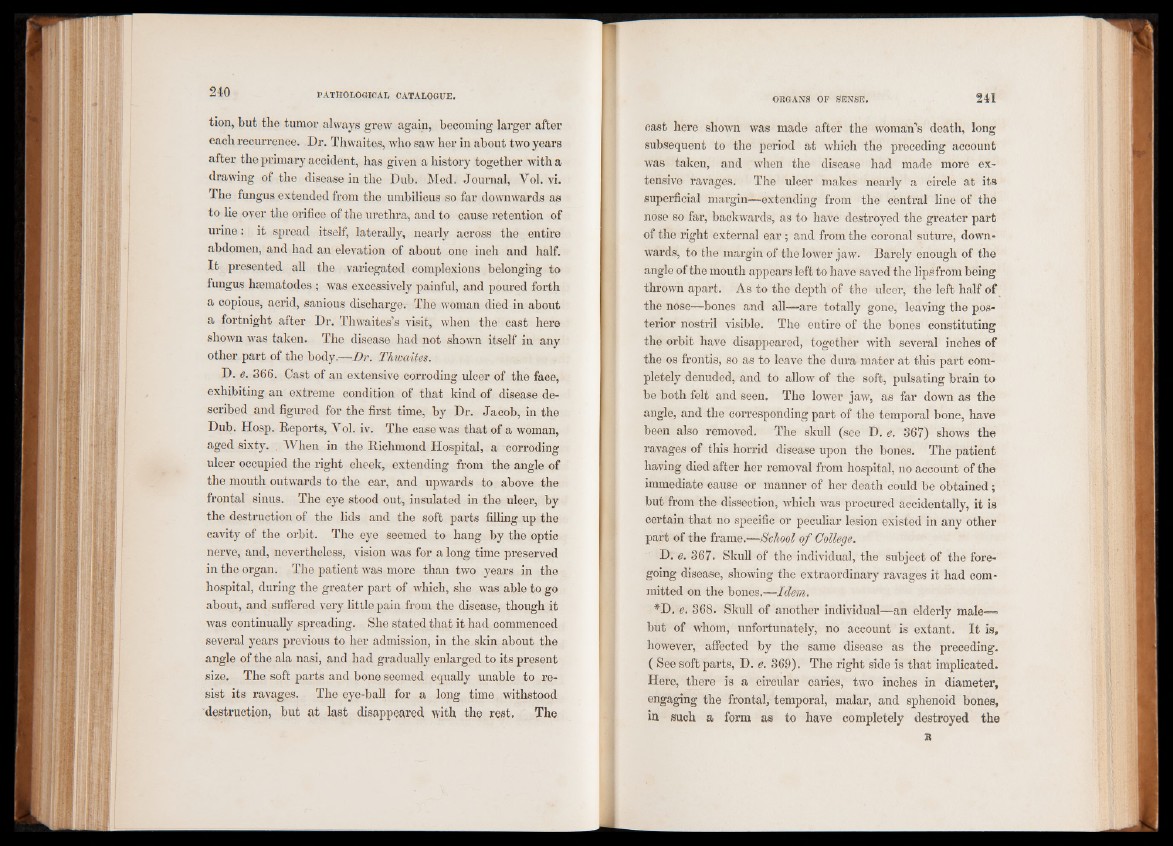
tion, but the tumor always grew again, becoming larger after
each recurrence. Dr. Thwaites, who saw her in about two years
after the primary accident, has given a history together with a
drawing of the disease in the Dub. Med. Journal, Vol. vi.
The fungus extended from the umbilicus so far downwards as
to lie over the orifice of the urethra, and to cause retention of
urine: it spread itself, laterally, nearly across the entire
abdomen, and had an elevation of about one inch and half.
It presented all the variegated complexions belonging to
fungus hsematodes; was excessively painful, and poured forth
a copious, acrid, sanious discharge. The woman died in about
a fortnight after Dr. Thwaites’s visit, when the cast here
shown was taken. The disease had not shown itself in any
other part of the body.—Dr. Thwaites.
D. e. 366. Cast of an extensive corroding ulcer of the face,
exhibiting an extreme condition of that kind of disease described
and figured for the first time, by Dr. Jacob, in the
Dub. Hosp. Reports, Vol. iv. The case was that of a woman,
aged sixty. , When in the Richmond Hospital, a corroding
ulcer occupied the right cheek, extending from the angle of
the mouth outwards to the ear, and upwards to above the
frontal sinus. The eye stood out, insulated in the ulcer, by
the destruction of the lids and the soft parts filling up the
cavity of the orbit. The eye seemed to hang by the optic
nerve, and, nevertheless, vision was for a long time preserved
in the organ. The patient was more than two years in the
hospital, during the greater part of which, she was able to go
about, and suffered very little pain from the disease, though it
was continually spreading. She stated that it had commenced
several years previous to her admission, in the.skin about the
angle of the ala nasi, and had gradually enlarged to its present
size. The soft parts and bone seemed equally unable to resist
its ravages. The eye-ball for a long time withstood
destruction, but at last disappeared with the rest. The
cast here shown was made after the woman’s death, long
subsequent to the period at which the preceding account
was taken, and when the disease had made more extensive
ravages. The ulcer makes nearly a circle at its
superficial margin—extending from the central line of the
nose so far, backwards, as to have destroyed the greater part
of the right external ear; and from the coronal suture, downwards,
to the margin of the lower jaw. Barely enough of the
angle of the mouth appears left to have saved the lips from being
thrown apart. As to the depth of the idcer, the left half of
the nose—bones and all—are totally gone, leaving the posterior
nostril visible. The entire of the bones constituting
the orbit have disappeared, together with several inches of
the os frontis, so as to leave the dura mater at this part completely
denuded, and to allow of the soft, pulsating brain to
be both felt and seen. The lower jaw, as far down as the
angle, and the corresponding part of the temporal bone, have
been also removed. The skull (see D. e. 367) shows the
ravages of this horrid disease upon the bones. The patient
having died after her removal from hospital, no account of the
immediate cause or manner of her death could be obtained;
but from the dissection, which was procured accidentally, it is
certain that no specific or peculiar lesion existed in any other
part of the frame.—School of College.
D. e. 367. Skull of the individual, the subject of the foregoing
disease, showing the extraordinary ravages it had committed
on the bones.—Idem.
*D. e. 368. Skull of another individual —an elderly male—
but of whom, unfortunately, no account is extant. It is,
however, affected by the same disease as the preceding.
( See soft parts, D. e. 369). The right side is that implicated.
Here, there is a circular caries, two inches in diameter,
engaging the frontal, temporal, malar, and sphenoid bones,
in such a form as to have completely destroyed the
B